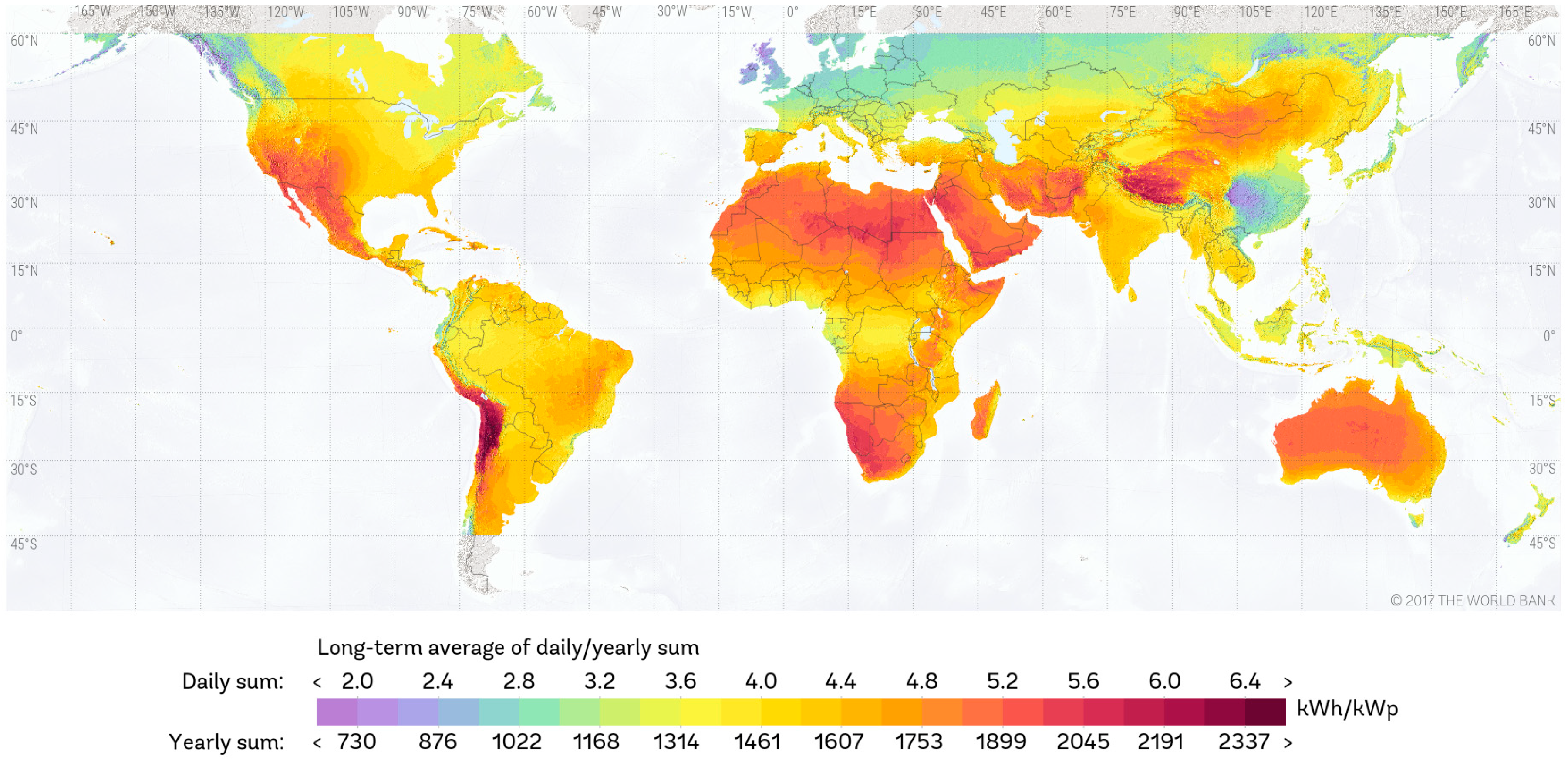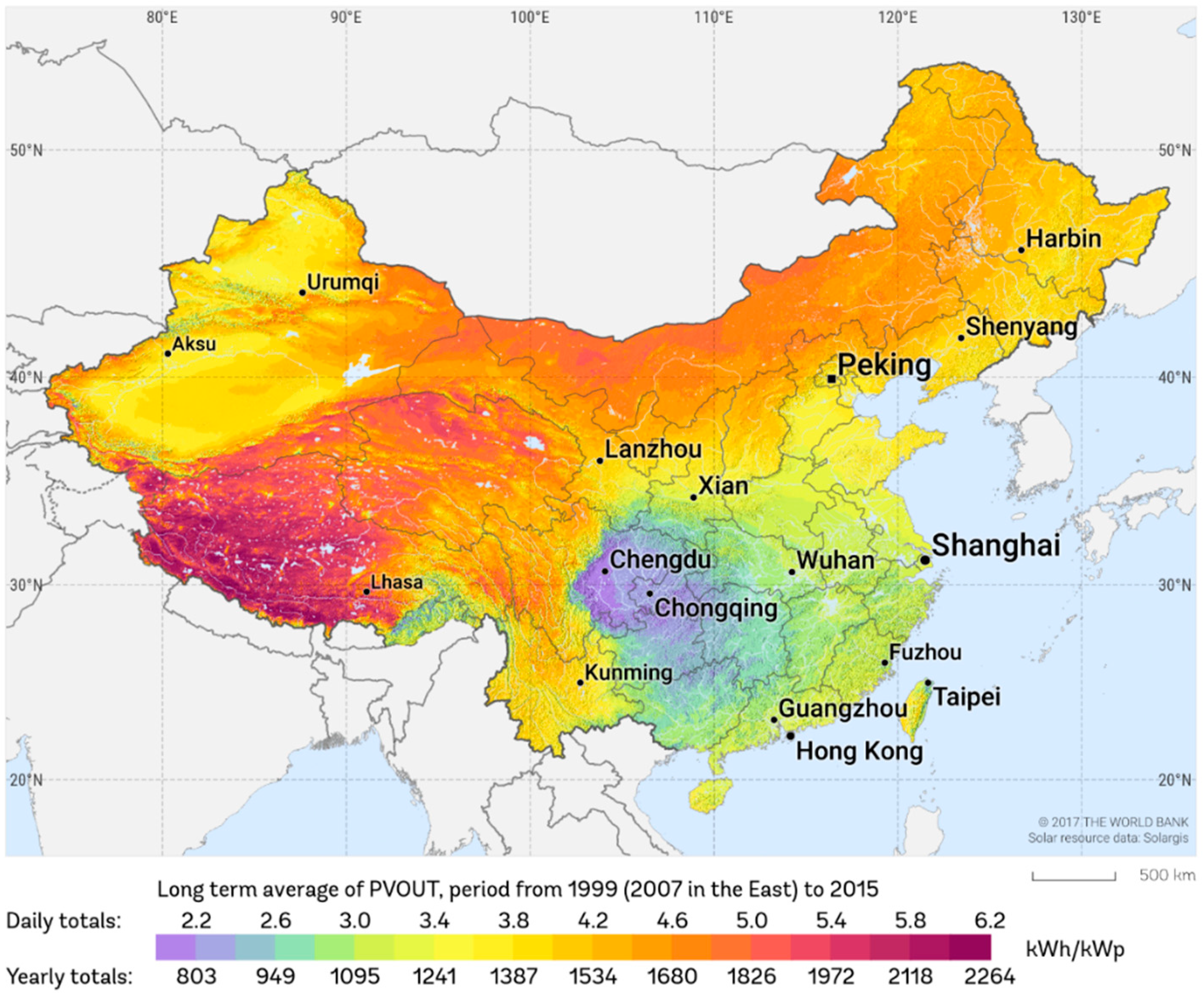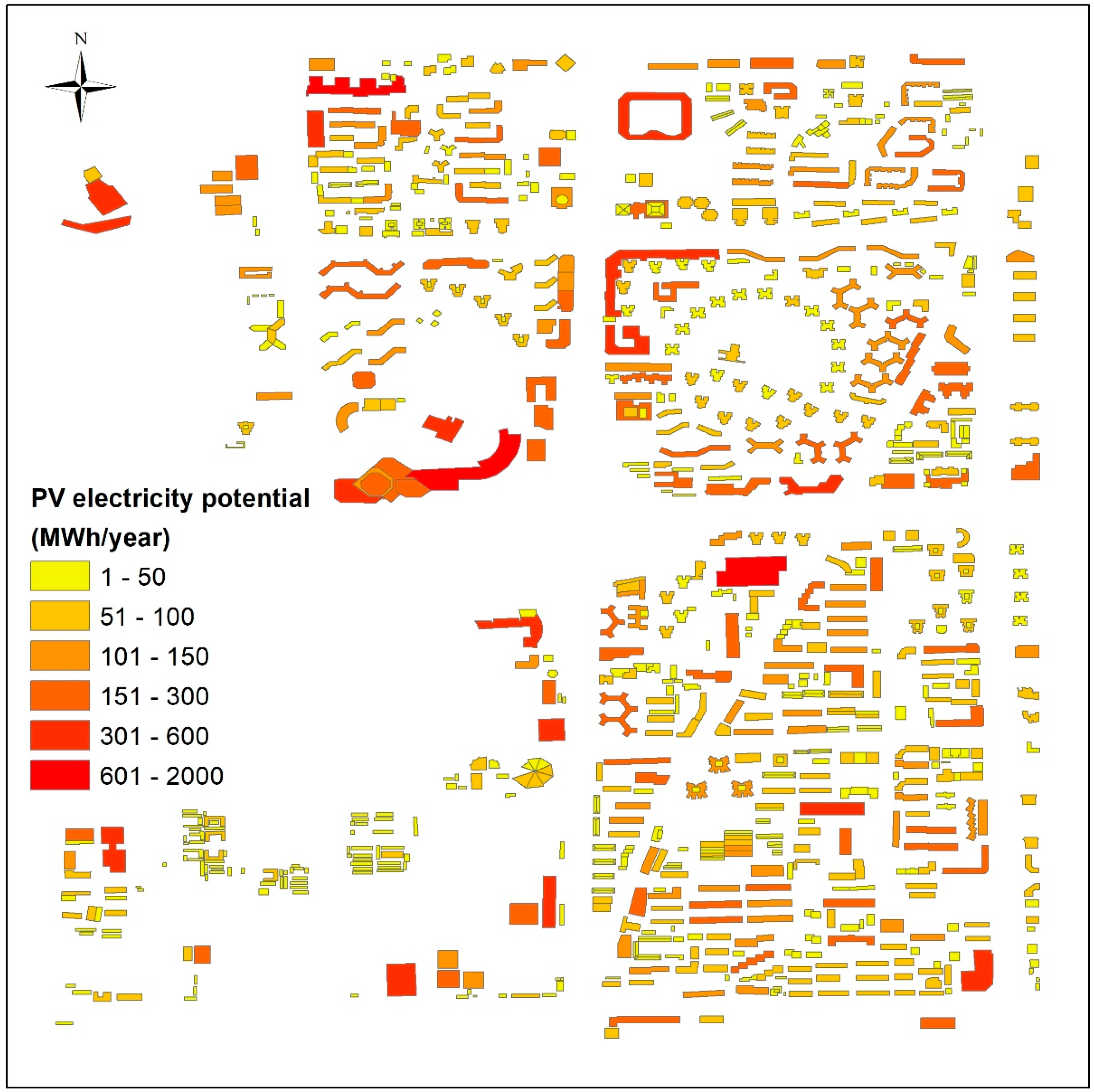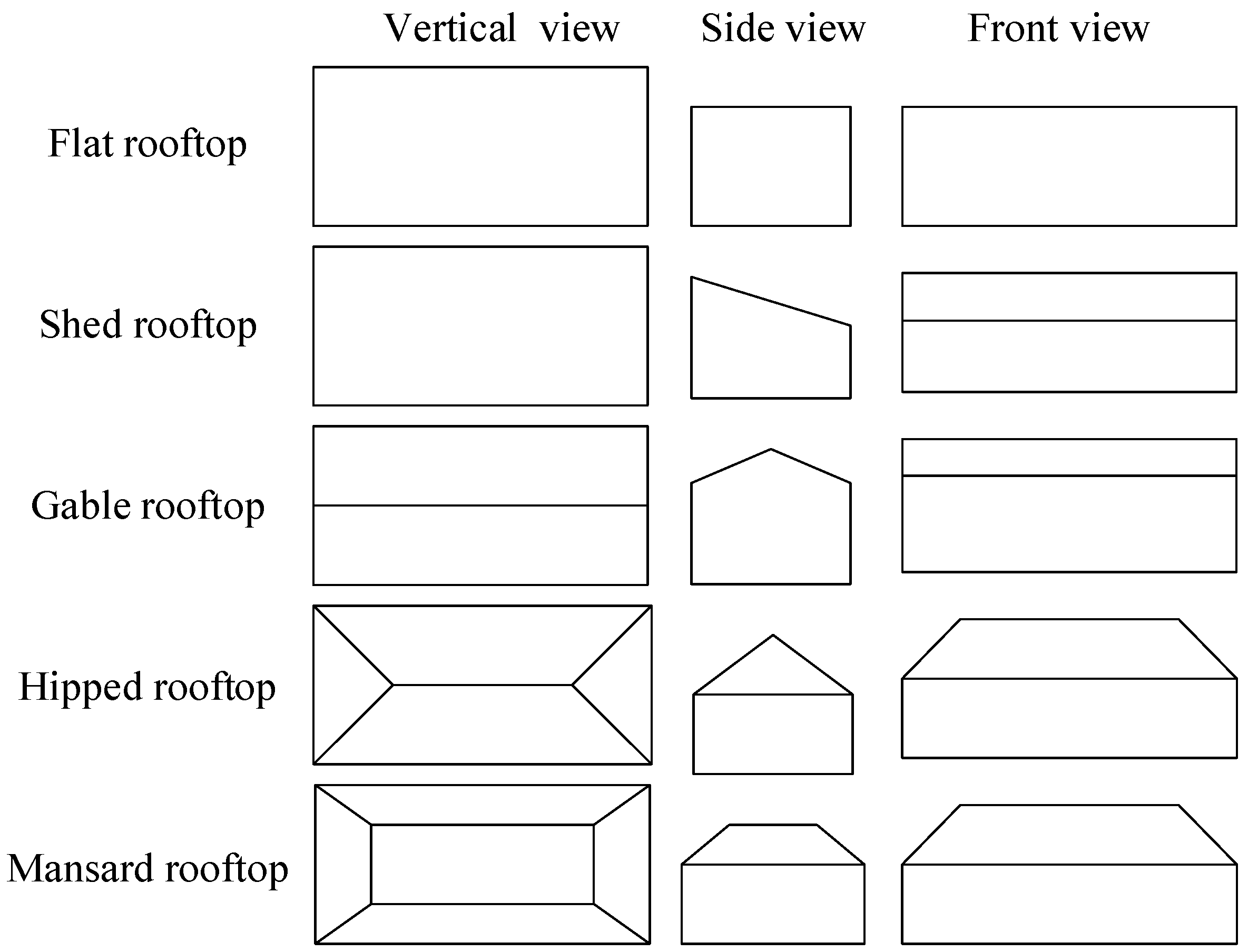An Approach for Estimating Solar Photovoltaic Potential Based on Rooftop Retrieval from Remote Sensing Images
Abstract
:1. Introduction
2. Results and Validation
2.1. Study Area and Data Sources
2.2. Building Extraction Results
2.3. Rooftop Assessment
2.4. PV Potential Assessment Results
3. Study Area and Data
3.1. Rooftop Outline Detection
3.2. Rooftop Feature Parameters Acquisition
3.3. Solar PV Module Moduleparameter Acquisition
3.4. Calculation of St and Rt
4. Conclusions
Author Contributions
Funding
Conflicts of Interest
References
- Rennings, K.; Wiggering, H. Steps towards indicators of sustainable development: Linking economic and ecological concepts. Ecol. Econ. 2016, 20, 25–36. [Google Scholar] [CrossRef]
- He, L.; Li, C.-L.; Nie, Q.-Y.; Men, Y.; Shao, H.; Zhu, J. Core Abilities Evaluation Index System Exploration and Empirical Study on Distributed PV-Generation Projects. Energies 2017, 10, 2083. [Google Scholar] [CrossRef]
- Zsiboracs, H.; Baranyai, N.H.; Vincze, A.; Háber, I.; Pintér, G. Economic and Technical Aspects of Flexible Storage Photovoltaic Systems in Europe. Energies 2018, 11. [Google Scholar] [CrossRef]
- Hong, T.; Lee, M.; Koo, C.; Kim, J.; Jeong, K. Estimation of the Available Rooftop Area for Installing the Rooftop Solar Photovoltaic (PV) System by Analyzing the Building Shadow Using Hillshade Analysis. Energy Procedia 2016, 88, 408–413. [Google Scholar] [CrossRef]
- Bazan, J.; Rieradevall, J.; Gabarrell, X.; Vázquez-Rowe, I. Low-carbon electricity production through the implementation of photovoltaic panels in rooftops in urban environments: A case study for three cities in Peru. Sci. Total Environ. 2018, 622–623, 1448–1462. [Google Scholar] [CrossRef] [PubMed]
- Henrik, Z.; Bai, A.; Popp, J.; Gabnai, Z.; Pályi, B.; Farkas, I.; Baranyai, N.H.; Veszelka, M.; Zentkó, L.; Pintér, G. Change of Real and Simulated Energy Production of Certain Photovoltaic Technologies in Relation to Orientation, Tilt Angle and Dual-Axis Sun-Tracking. A Case Study in Hungary. Sustainability 2018, 10, 1394. [Google Scholar] [CrossRef]
- Pintér, G.; Baranyai, N.H.; Wiliams, A.; Zsiborács, H. Study of Photovoltaics and LED Energy Efficiency: Case Study in Hungary. Energies 2018, 11, 790. [Google Scholar] [CrossRef]
- Cucchiella, F.; Adamo, I.D.; Gastaldi, M. Economic Analysis of a Photovoltaic System: A Resource for Residential Households. Energies 2017, 10, 814. [Google Scholar] [CrossRef]
- Ding, L.; Zhang, F.; Shuai, J. How Do Chinese Residents Expect of Government Subsidies on Solar Photovoltaic Power Generation?—A Case of Wuhan, China. Energies 2018, 11, 228. [Google Scholar] [CrossRef]
- Singh, R.; Banerjee, R. Estimation of rooftop solar photovoltaic potential of a city. Sol. Energy 2015, 115, 589–602. [Google Scholar] [CrossRef]
- SolarGIS. Available online: https://solargis.com/maps-and-gis-data/download/world (accessed on 6 November 2018).
- SolarGIS. Available online: https://solargis.com/maps-and-gis-data/download/China (accessed on 6 November 2018).
- Psomopoulos, C.S.; Ioannidis, G.C.; Kaminaris, S.D.; Mardikis, K.D.; Katsikas, N.G. A Comparative Evaluation of Photovoltaic Electricity Production Assessment Software (PVGIS, PVWatts and RETScreen). Environ. Process. 2015, 2, 175–189. [Google Scholar] [CrossRef]
- Photovoltaic Geographical Information System. Available online: http://re.jrc.ec.europa.eu/pvg_tools/en/tools.html#PVP (accessed on 6 November 2018).
- PVWatts® Calculator. Available online: https://pvwatts.nrel.gov (accessed on 6 November 2018).
- Melius, J. Estimating Rooftop Suitability for PV: A Review of Methods, Patents, and Validation Techniques; National Renewable Energy Laboratory: Golden, CO, USA, 2013. [Google Scholar] [CrossRef]
- Lin, A.; Lu, M.; Sun, P. The Influence of Local Environmental, Economic and Social Variables on the Spatial Distribution of Photovoltaic Applications across China’s Urban Areas. Energies 2018, 11, 1986. [Google Scholar] [CrossRef]
- Zhang, H. Evaluation method and application of photovoltaic potential of urban building roof. Urban Probl. 2017. [Google Scholar] [CrossRef]
- Izquierdo, S.; Rodrigues, M.; Fueyo, N. A method for estimating the geographical distribution of the available roof surface area for large-scale photovoltaic energy-potential evaluations. Sol. Energy 2008, 82, 929–939. [Google Scholar] [CrossRef] [Green Version]
- Wiginton, L.K.; Nguyen, H.T.; Pearce, J.M. Quantifying rooftop solar photovoltaic potential for regional renewable energy policy. Comput. Environ. Urban Syst. 2010, 34, 345–357. [Google Scholar] [CrossRef]
- Ladner-Garcia, H.P.; O’Neill-Carrillo, E. Determining realistic photovoltaic generation targets in an isolated power system. power and energy society general meeting. In Proceedings of the 2009 IEEE Power & Energy Society General Meeting, Calgary, AB, Canada, 26–30 July 2009; pp. 1–5. [Google Scholar] [CrossRef]
- Vardimon, R. Assessment of the potential for distributed photovoltaic electricity production in Israel. Renew. Energy 2011, 36, 591–594. [Google Scholar] [CrossRef]
- Sørensen, B. GIS management of solar resource data. Sol. Energy Mater. Sol. Cells 2001, 67, 503–509. [Google Scholar] [CrossRef]
- Gamal, L.; Effat, H.A. GIS-Based Estimation of Potential Solar Energy on Flat Roofs in Maadi, Cairo, using True Ortho World View Image and Digital Surface Model. Int. J. Adv. Remote Sens. GIS 2015. [Google Scholar] [CrossRef]
- Izquierdo, S.; Montañés, C.; Dopazo, C.; Fueyo, N. Roof-top solar energy potential under performance-based building energy codes: The case of Spain. Sol. Energy 2011, 85, 208–213. [Google Scholar] [CrossRef] [Green Version]
- Jo, J.H.; Otanicar, T.P. A hierarchical methodology for the mesoscale assessment of building integrated roof solar energy systems. Renew. Energy 2011, 36, 2992–3000. [Google Scholar] [CrossRef]
- Jakubiec, J.A.; Reinhart, C.F. A method for predicting city-wide electricity gains from photovoltaic modules based on LiDAR and GIS data combined with hourly Daysim simulations. Sol. Energy 2013, 93, 127–143. [Google Scholar] [CrossRef]
- Jacques, D.A.; James, G.; Jannik, G.; Jacques, D.A.; Gooding, J.; Giesekam, J.J.; Tomlin, A.S.; Crook, R. Methodology for the assessment of PV capacity over a city region using low-resolution LiDAR data and application to the City of Leeds (UK). Appl. Energy 2014, 124, 28–34. [Google Scholar] [CrossRef] [Green Version]
- Schuffert, S.; Voegtle, T.; Tate, N.; Ramirez, A. Quality Assessment of Roof Planes Extracted from Height Data for Solar Energy Systems by the EAGLE Platform. Remote Sens. 2015, 7, 17016–17034. [Google Scholar] [CrossRef] [Green Version]
- Li, Z.; Zhang, Z.; Davey, K. Estimating Geographical PV Potential Using LiDAR Data for Buildings in Downtown San Francisco. Trans. GIS 2016, 19, 930–963. [Google Scholar] [CrossRef]
- Google Maps. Available online: https://maps.google.com (accessed on 6 November 2018).
- National Bureau of Statistics. China Statistical Yearbook; China Statistics Press: Beijing, China, 2017; ISBN 978-7-5037-8253-4.
- Kurdgelashvili, L.; Li, J.; Shih, C.-H.; Attia, B. Estimating technical potential for rooftop photovoltaics in California, Arizona and New Jersey. Renew. Energy 2016, 95, 286–302. [Google Scholar] [CrossRef] [Green Version]
- Sakarapunthip, N.; Chenvidhya, D.; Chuangchote, S.; Kirtikara, K.; Chenvidhya, T.; Onreabroy, W. Effects of dust accumulation and module cleaning on performance ratio of solar rooftop system and solar power plants. Jpn. J. Appl. Phys. 2017, 56. [Google Scholar] [CrossRef]
- Song, X.; Jiang, X.; Jiang, D.; Hunag, Y.; Wan, H.; Wang, C. Object-oriented Classification of High-resolution Remote Sensing Image. Remote Sens. Technol. Appl. 2015, 30, 99–105. [Google Scholar] [CrossRef]
- Turker, M.; Koc-San, D. Building extraction from high-resolution optical spaceborne images using the integration of support vector machine (SVM) classification, Hough transformation and perceptual grouping. Int. J. Appl. Earth Obs. Geoinf. 2015, 34, 58–69. [Google Scholar] [CrossRef]
- Partovi, T.; Huang, H.; Kraus, T.; Mayer, H.; Reinartz, P. Statistical Building Roof Reconstruction from WORLDVIEW-2 Stereo Imagery. Int. Arch. Photogramm. Remote Sens. Spat. Inf. Sci. 2015, XL-3/W2, 161–167. [Google Scholar] [CrossRef]
- Li, F.; Li, J.Z.; Zhang, Q.-X. Algorithm Comparison of Slope and Aspect from DEM. J. Anhui Agric. Sci. 2008, 36, 7355–7357. [Google Scholar] [CrossRef]
- Zhu, D.D.; Yan, D. Calculation of Solar Radiation and Generated Energy on Inclined Plane and Optimal Inclined Angle. Build. Sci. 2012. [Google Scholar] [CrossRef]
- Chen, J.; Liu, H.; Jiang, B. Design of PV Array Spacing on the Roof with Arbitrary Slope Azimuth. Electr. Power Sci. Eng. 2016, 32, 26–30. [Google Scholar] [CrossRef]
- Loutzenhiser, P.G.; Manz, H.; Felsmann, C.; Strachand, P.A.; Franka, T.; Maxwellb, G.M. Empirical validation of models to compute solar irradiance on inclined surfaces for building energy simulation. Sol. Energy 2007, 81, 254–267. [Google Scholar] [CrossRef] [Green Version]
- Wu, Y.-Z.; Zou, L.J. The calculation of spacing between solar cell array in photovoltaic pouler station. Energy Eng. 2011. [Google Scholar] [CrossRef]
- Kacira, M.; Simsek, M.; Babur, Y.; Demirkol, S. Determining optimum tilt angles and orientations of photovoltaic panels in Sanliurfa, Turkey. Renew. Energy 2004, 29, 1265–1275. [Google Scholar] [CrossRef]
- Mehleri, E.D.; Zervas, P.L.; Sarimveis, H.; Palyvos, J.A.; Markatos, N.C. Determination of the optimal tilt angle and orientation for solar photovoltaic arrays. Renew. Energy 2010, 35, 2468–2475. [Google Scholar] [CrossRef]









| Number | Type | Area (m2) | Slope (°) | Aspect | ||||
|---|---|---|---|---|---|---|---|---|
| Method | Actual | Method | Actual | Method | Actual | Method | Actual | |
| 1 | 0 | 0 | 9263.17 | 9000 | 0 | 0 | 0 | - |
| 2 | 0 | 0 | 1676.52 | 1700 | 0 | 0 | 0 | - |
| 3 | 1 | 1 | 357.86 | 380 | 15 | 20 | 120 | 120 |
| 4 | 0 | 0 | 304.02 | 320 | 0 | 0 | 0 | - |
| 5 | 1 | 1 | 274.24 | 300 | 48 | 45 | 0 | 0 |
| 6 | 1 | 1 | 310.55 | 360 | 13 | 16 | 180 | 180 |
| 7 | 1 | 1 | 255.43 | 220 | 15 | 20 | 0 | 0 |
| 8 | 1 | 1 | 44.01 | 40 | 36.3 | 40 | 90 | 90 |
| 9 | 1 | 1 | 214.78 | 260 | 46.3 | 50 | 270 | 270 |
| 10 | 1 | 1 | 403.98 | 410 | 21.8 | 17 | 0 | 0 |
| Error: | 0% | Error: | 8.24% | Error: | 12.03% | Error: | 0% | |
| Rooftop Type | Aspect Types Detailed Description |
|---|---|
| Flat rooftop | No dominant aspect types |
| Shed rooftop | One dominant aspect types |
| Gable rooftop | Two opposite dominant aspect types |
| Hipped rooftop | Two large area of opposite aspect types and two small area of opposite aspect types |
| Mansard rooftop | Four similar area of aspect types and a small flat rooftop |
| Rooftop Type | Hip | Sunny Hip | Area | Slope | Aspect |
|---|---|---|---|---|---|
| Flat rooftop | √ | ||||
| Shed rooftop | √ | √ | √ | ||
| Gable rooftop | longitudinal | √ | √ | √ | √ |
| longitudinal | √ | √ | √ | ||
| Hipped rooftop | longitudinal | √ | √ | √ | √ |
| longitudinal | √ | √ | √ | √ | |
| Lateral | √ | √ | √ | √ | |
| Lateral | |||||
| Mansard rooftop | flat | √ | |||
| longitudinal | √ | √ | √ | √ | |
| longitudinal | √ | √ | √ | √ | |
| Lateral | √ | √ | √ | √ | |
| Lateral |
© 2018 by the authors. Licensee MDPI, Basel, Switzerland. This article is an open access article distributed under the terms and conditions of the Creative Commons Attribution (CC BY) license (http://creativecommons.org/licenses/by/4.0/).
Share and Cite
Song, X.; Huang, Y.; Zhao, C.; Liu, Y.; Lu, Y.; Chang, Y.; Yang, J. An Approach for Estimating Solar Photovoltaic Potential Based on Rooftop Retrieval from Remote Sensing Images. Energies 2018, 11, 3172. https://doi.org/10.3390/en11113172
Song X, Huang Y, Zhao C, Liu Y, Lu Y, Chang Y, Yang J. An Approach for Estimating Solar Photovoltaic Potential Based on Rooftop Retrieval from Remote Sensing Images. Energies. 2018; 11(11):3172. https://doi.org/10.3390/en11113172
Chicago/Turabian StyleSong, Xiaoyang, Yaohuan Huang, Chuanpeng Zhao, Yuxin Liu, Yanguo Lu, Yongguo Chang, and Jie Yang. 2018. "An Approach for Estimating Solar Photovoltaic Potential Based on Rooftop Retrieval from Remote Sensing Images" Energies 11, no. 11: 3172. https://doi.org/10.3390/en11113172
APA StyleSong, X., Huang, Y., Zhao, C., Liu, Y., Lu, Y., Chang, Y., & Yang, J. (2018). An Approach for Estimating Solar Photovoltaic Potential Based on Rooftop Retrieval from Remote Sensing Images. Energies, 11(11), 3172. https://doi.org/10.3390/en11113172






